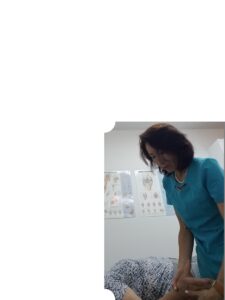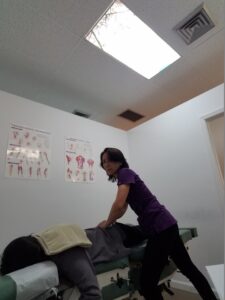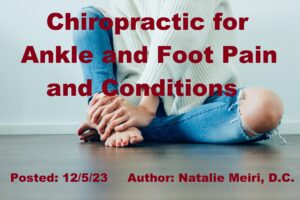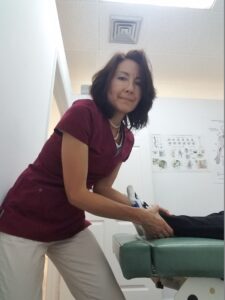
A common source of joint fixation/chiropractic subluxation (hypomobility) and dysfunction is periarticular (surrounding joint) soft tissue injury with its resultant fibrosis (thickening or scarring of the tissue) and loss of elasticity and strength. So soft tissue injury and fibrosis may result from trauma to muscular, tendinous, myofascial, or ligamentous tissue. And you may have had acute trauma or repetitive injury to the area to cause it.
Chiropractic Adjustments Restore Motion
First, an inflammatory response is triggered resulting in an extracellular (taking place outside of cell) accumulation of exudates (fluid that leaks out of blood vessels) and blood. Platelets (tiny blood cells that help your body form clots to stop bleeding) then release thrombin (molecule which helps in clotting process) converting fibrinogen into fibrin, which organizes into collagenous scar tissue. This results in a variety of soft tissue and articular (joint) adhesions.
Second, the above response can often be excessive especially in traumatic neuromusculoskeletal injuries. Therefore, therapies for minimizing inflammatory exudates are helpful. This will in turn reduce pain and muscle spasm. Ultimately, this leads to early pain-free mobilization and flexible repair.
Third, early care and mobilization provide the best opportunity for optimal healing.
In contrast, bed rest and prolonged inactivity increases the chances of long-term disability and eventually lost time from work.
Fourth, the exudates that arise due to injury and inflammation gets the next step ready of connective tissue repair. Moreover, the matrix for the development of granulation tissue (new connective tissue) and scar formation is set. And the formation of granulation tissue is mostly carried out by the rapid increase of fibroblasts (cells that contribute to the formation of connective tissue). Next, fibroblasts synthesize and deposit collagen tissue. At first, the collagen is poorly organized. And additional collagen cross-linkages to reorganize along planes of stress which improves the tensile (stretchability) strength of the injured area sets forth.
Fifth, this repair and remodeling process may take months and may result in less than optimal healing and extensibility (stretchability) of the involved tissue. Of course, immobilization slows recovery. This results in a loss of strength and flexibility and possible intra-articular (within the joint) fatty adhesions. Immobilization also leads to dehydration, causing proteoglycans (substance which provides hydration and swelling pressure to the tissue enabling it to withstand compressional forces) to get closer and stick together.
In conclusion, if injury or immobilization leads to decreased flexibility, therapies such as chiropractic adjustments are directed toward the restoration of motion.
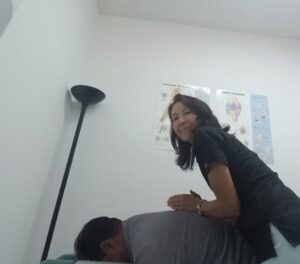
Myofascial Cycle of Pain
Myofascial refers to the muscle or of the fascia (layer of connective tissue that supports tissues and organs) surrounding the muscle. So myofascial conditions are triggered by many reasons. This can become self-perpetuating sources of pain, muscle spasm, and joint dysfunction.
Additionally, painful conditions which cause chronic muscle hypotoncity (deficient tone) are additional origins of restricted joint motion. In other words, muscle contraction, once initiated, may become a self-perpetuating source of pain and muscle hypotoncity. Protective splinting in the joint’s intrinsic muscles may further this process by stopping passive joint movement and the pain-inhibiting qualities of certain joint receptors.
If contractions continue, over time they may develop into muscle contractures. This is a result of adaptational shortening and loss of elasticity from disuse or underuse. Problems capable of producing muscle contraction are: trauma, structural inadequacies, visceral (organ) disease, emotional distress, and exposure to cold.
Myofascial Cycle Summary
- Joint Dysfunction leads to muscle strain.
- Muscle strain is caused by: Repetitive use, Emotional tension, Chronic postural stress, Exposure to cold, Visceral disease, Physical trauma, structural inadequacies, uncoordinated movements
- Vasoconstriction (narrowing of blood vessels by small muscles in their walls) and ischemia (inadequate blood supply) is caused by the pain of muscle strain. So pain causes muscle splinting. This in turn leads to retained metabolites and edema (inflammation).
- Sustained contraction happens due to vasoconstriction/ischemia and along the way myofascial syndromes and joint dysfunction occur.
- Fibrous reaction occurs finally and leads to soft tissue contractures.
- And Soft tissue contractures lead to Persistent joint and somatic (skin, muscles, joints, and bones) dysfunction as the end result.

Some Causes of Chiropractic Subluxations: Stopping the Myofascial Pain Cycle
Behaviors or bad habits can cause subluxations. For example the following may contribute: continuously carrying a purse or bag on the same side of your body, sleeping on your stomach, sleeping with a pillow that is too big or too flat for you, crossing your legs or looking down at a computer monitor for long periods of time, sitting for long hours, and improper lifting. Also, de-stressing and decreasing your exposure to cold (e.g. excessive air conditioning) may help.
Meiri Chiropractic utilizes the best joint manipulation and adjustments to the spine and peripheral joints. We provide soft tissue procedures, hot and cold modalities, stretching/ rehabilitation exercises, and homeopathic consultations as well.
At Meiri Chiropractic in West Palm Beach we spend the time necessary to examine, diagnose and treat every neuromusculoskeletal condition and various ailments you have. Through regular chiropractic visits, you can get pain relief and improve function. Chiropractic is a holistic and natural way to treat existing conditions. And your body will be in its best working condition with regular chiropractic care. Meiri Chiropractic has been offering effective chiropractic care in Palm Beach county since 2006. Many of our patient reviews note our excellence. Call us today at 561-253-8984 in West Palm Beach to make an appointment.
References: Thomas Bergman, David Peterson, (3rd edition) Chiropractic Technique: Principles and Procedure



